Brother sewing machines are trusted for durability and versatility, catering to diverse sewing tasks. The user manual offers detailed guidance for optimal performance and troubleshooting, ensuring efficient operation.
1.1 Key Features and Benefits of Brother Sewing Machines
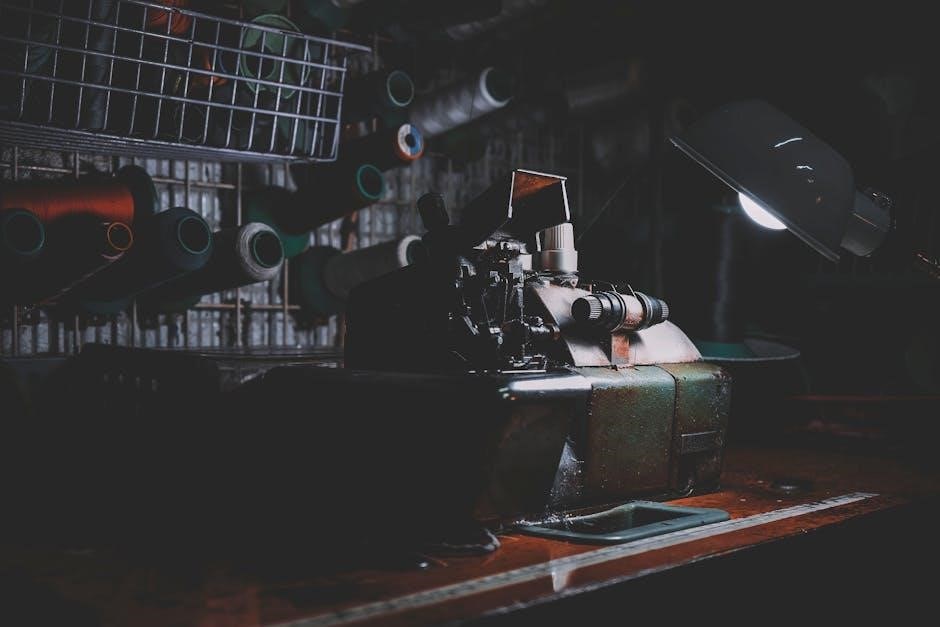
Brother sewing machines are renowned for their versatility, durability, and user-friendly design. They offer a wide range of stitch options, automatic threading, and tension control, making them ideal for both beginners and experienced sewists. Many models feature a free arm for sewing difficult-to-reach areas, such as cuffs and sleeves. The machines are also equipped with robust motors for smooth operation and consistent stitching. Additionally, Brother sewing machines are known for their affordability and reliability, providing excellent value for hobbyists and professionals alike. The included user manual ensures easy setup and operation, while the availability of online resources and support further enhances the overall sewing experience.
1.2 Importance of Using the User Manual
The user manual is an essential resource for understanding and safely operating your Brother sewing machine. It provides detailed instructions for setup, maintenance, and troubleshooting, ensuring optimal performance. The manual highlights safety precautions, such as avoiding blocked air openings and keeping the machine away from heat sources, to prevent accidents. It also guides users through basic operations, stitch selection, and advanced features like the free arm function. By following the manual, users can avoid common errors and extend the machine’s lifespan. Additionally, it serves as a reference for resolving issues and knowing when professional repair is needed. Accessing the manual online or through the Brother Solutions Center ensures you always have the latest guidance at your fingertips.
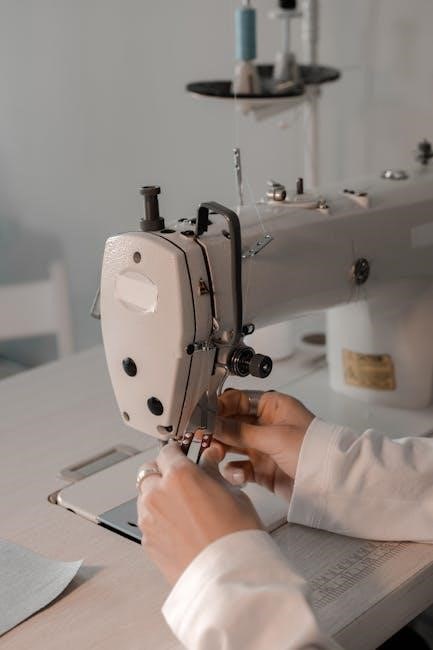
Safety Precautions When Using Brother Sewing Machines

Always follow safety guidelines to prevent accidents. Keep ventilation openings clear, avoid heat sources, and ensure stable placement. Never operate near flammable materials or with blocked air vents.
2.1 General Safety Tips for Operating the Sewing Machine
Always prioritize safety when using a Brother sewing machine. Ensure the machine is placed on a stable, flat surface to prevent accidental tipping. Keep children and pets away while operating. Avoid wearing loose clothing or jewelry that could get caught in moving parts. Never touch the needle or other sharp components with bare hands. Ensure good lighting in the work area to maintain visibility. Unplug the machine when not in use or during maintenance. Regularly inspect the power cord and plug for damage; Follow the user manual’s guidelines for proper usage and avoid overloading the machine. Keep flammable materials away from the sewing area to minimize fire risks.
2.2 Specific Precautions for Electrical and Mechanical Safety
- Always unplug the sewing machine before cleaning, lubricating, or performing any maintenance to avoid electrical shocks or injuries.
- Ensure the machine’s ventilation openings are free from lint, dust, and fabric debris to prevent overheating.
- Avoid operating the machine near heat sources, such as stoves or irons, as this can ignite flammable materials or cause electrical issues.
- Never use the machine in damp environments or expose it to water, as this can lead to electrical hazards or damage.
- Check the power cord and plug regularly for signs of wear or damage; do not use the machine if any components are compromised.
- Keep the sewing machine on a stable, level surface to prevent mechanical instability and ensure proper function.
By following these guidelines, you can minimize risks and ensure safe, efficient operation of your Brother sewing machine.
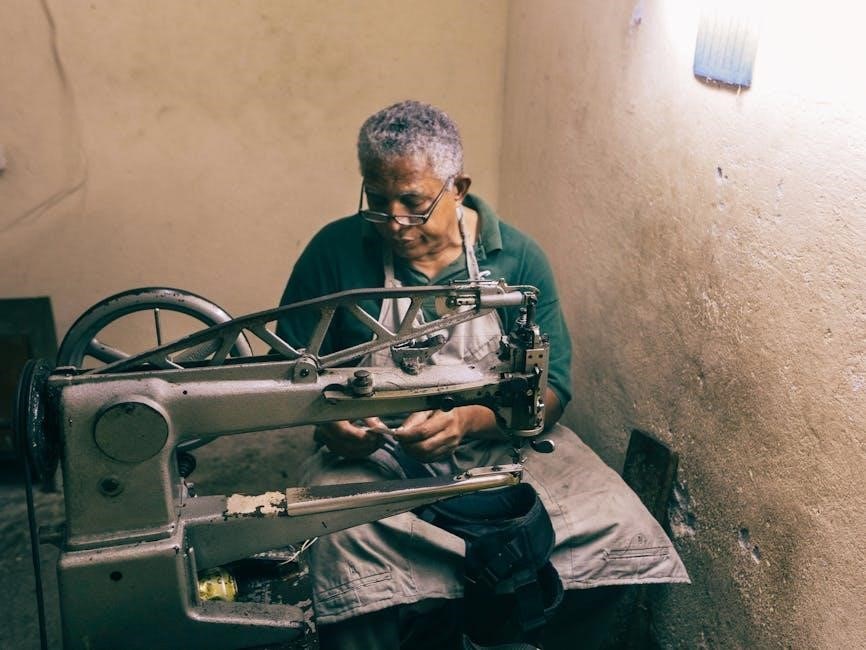
Setting Up Your Brother Sewing Machine
Setting up your Brother sewing machine involves unboxing, placing it on a stable surface, understanding its parts, and checking all included accessories to ensure proper functionality.
3.1 Unboxing and Initial Inspection
When unboxing your Brother sewing machine, carefully remove it from the packaging and inspect for any visible damage. Ensure all accessories, such as the power cord, foot pedal, and sewing feet, are included. Review the user manual to understand the machine’s components and features. Before first use, check for loose parts and ensure the machine is clean. Familiarize yourself with the control panel and stitch selections. For specific models like the Brother XL 5340, verify the inclusion of the free arm and additional stitch guides. If any items are missing or damaged, contact Brother support immediately. Always follow the manual’s guidance for initial setup and maintenance to ensure optimal performance and safety.
3.2 Placing the Sewing Machine on a Stable Surface
Position your Brother sewing machine on a stable, flat surface to ensure smooth operation. Avoid unstable or slanted tables, as this could cause the machine to tip over. Choose a surface that is sturdy enough to support the machine’s weight and remain vibration-free during use. Ensure the area is clear of clutter and away from heat sources or water to prevent damage. For optimal performance, place the machine on a surface that allows easy access to the free arm and controls. Always follow the user manual’s recommendations for placement to maintain safety and functionality. Proper positioning enhances sewing accuracy and extends the machine’s lifespan.
3.3 Understanding the Basic Parts and Accessories
Familiarize yourself with the key components of your Brother sewing machine to maximize its functionality. The free arm allows easy access to difficult-to-reach areas, while the presser foot ensures fabric stability. The stitch selector enables you to choose from various stitch patterns, and the bobbin holds the lower thread. Additional accessories like needles, bobbins, and presser feet are essential for different fabrics and techniques. Understanding these parts helps you operate the machine efficiently and troubleshoot common issues. Refer to the user manual for detailed descriptions and diagrams to identify and use each component correctly. Proper use of these parts ensures optimal performance and extends the machine’s lifespan.

Operating the Sewing Machine
Start by turning on the machine and selecting the desired stitch type. Guide the fabric smoothly under the needle, using the free arm for curved or hard-to-reach areas.
4.1 Basic Sewing Operations and Functions
Begin by turning on the sewing machine and ensuring the needle is properly threaded. Select the appropriate stitch type based on your fabric. Guide the fabric smoothly under the needle, maintaining steady control. Use the foot pedal to regulate sewing speed. For straight stitching, align the fabric edge with the machine’s guide. Reverse stitching is used to secure seams at the beginning and end. The free arm is ideal for sewing cuffs, sleeves, or other curved areas. Always keep your hands away from the needle and ensure the work area is clear of loose materials. Refer to the manual for specific stitch settings and troubleshooting common issues during operation.
4.2 Selecting the Right Stitch Type for Your Fabric
Selecting the appropriate stitch type is crucial for achieving professional results. For lightweight fabrics like cotton or polyester, use a straight stitch or basic running stitch. Heavier fabrics, such as denim, require a stronger stitch like the denim or heavy-duty stitch. Delicate fabrics, such as silk or lace, benefit from a fine or zigzag stitch to prevent tearing. Knit fabrics should use a stretch stitch to allow flexibility. Consult the user manual for specific stitch recommendations based on fabric type. Use the stitch selector dial or digital interface to choose the correct stitch number. Always test the stitch on a scrap piece of fabric before sewing your final project to ensure the best results.
4.3 Using the Free Arm for Difficult-to-Reach Areas
The free arm on Brother sewing machines is a versatile feature designed for sewing hard-to-reach areas, such as cuffs, sleeves, and pant legs. To use it, detach the auxiliary arm or extend the free arm, depending on your machine model. This allows easy access to curved or narrow sections of fabric. When sewing, stabilize the fabric by gently guiding it under the needle. For delicate areas, reduce the stitch length to maintain control and prevent fabric stretching. Always refer to the user manual for specific instructions on activating and utilizing the free arm for your particular Brother model. This feature enhances precision and makes sewing intricate projects more manageable.
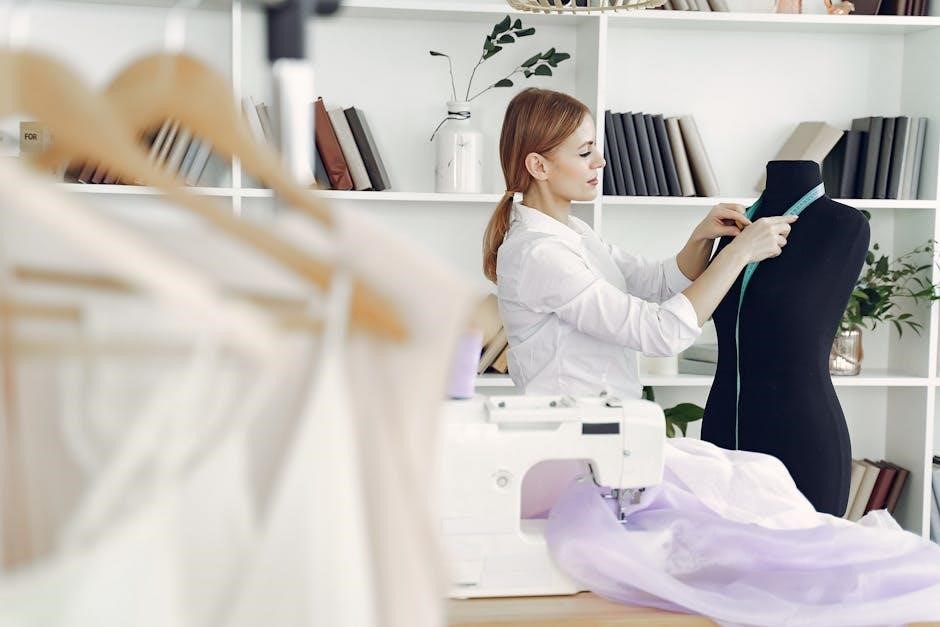
Maintenance and Troubleshooting
Regular maintenance ensures optimal performance. Clean and lubricate the machine, check for common issues, and consult the user manual for specific troubleshooting guidance and solutions.
5.1 Cleaning and Lubricating the Sewing Machine
Regular cleaning and lubrication are essential for maintaining your Brother sewing machine. Always unplug the machine before cleaning to avoid accidents. Use a soft brush to remove lint and debris from the bobbin area and tension discs. Lubricate moving parts with high-quality sewing machine oil as specified in the user manual. Avoid over-lubrication, as it may attract dust and cause mechanical issues. For detailed guidance, refer to the manual’s maintenance section, which provides step-by-step instructions for different models. Proper care ensures smooth operation, prevents wear, and extends the machine’s lifespan. Always follow safety precautions during maintenance to ensure optimal performance and reliability.
5.2 Common Issues and How to Resolve Them
Common issues with Brother sewing machines include thread jams, uneven stitching, and machine noise. To resolve thread jams, gently remove the bobbin and clear any tangled threads. For uneven stitching, check thread tension and ensure the correct stitch type is selected. If the machine is noisy, inspect for dust or debris and lubricate moving parts. Refer to the user manual for troubleshooting guides specific to your model. If issues persist, contact Brother customer support or visit an authorized service center for professional assistance. Regular maintenance and following manual guidelines can help prevent these problems, ensuring smooth operation and extending the machine’s lifespan. Always prioritize safety when addressing any mechanical issues.
5.3 When to Contact a Professional for Repair
Contact a professional if your Brother sewing machine experiences internal damage to gears or motors, or if there are broken needles and electrical issues. Seek expert help for persistent problems despite troubleshooting. Complex repairs like timing adjustments or sensor replacements require authorized technicians. Use Brother’s official support to find authorized service centers and ensure warranty compliance. Always follow the user manual’s guidelines for professional repairs to maintain performance and safety.
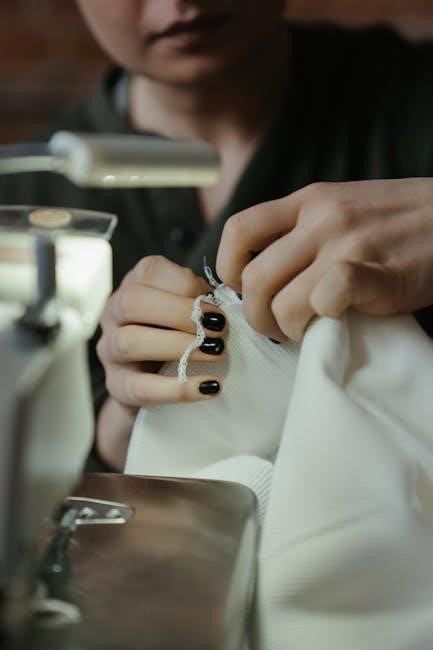
Additional Resources and Support
Explore the Brother Solutions Center for manuals, FAQs, and troubleshooting. Join online communities and forums for tips and advice from experienced users and Brother support experts.
6.1 Accessing the Official Brother Solutions Center
The Brother Solutions Center is a comprehensive online resource designed to support users of Brother sewing machines. To access it, visit the official Brother website and navigate to the support section. From there, you can search for your specific sewing machine model to find relevant materials. The center offers a variety of resources, including downloadable user manuals, product FAQs, and troubleshooting guides. Additionally, you can find the latest drivers and software updates to ensure your machine operates at peak performance. This centralized hub is a valuable tool for both new and experienced users, providing easy access to the information and tools needed to maintain and enhance your sewing experience. By utilizing the Brother Solutions Center, you can optimize your machine’s functionality and resolve any issues promptly.
6.2 Downloading Manuals and Guides for Specific Models
Downloading manuals and guides for specific Brother sewing machine models is straightforward through the Brother Solutions Center. Visit the official Brother website and navigate to the support section. Click on “Manuals” to access a dedicated page where you can search for your model by name or product category. Enter your model number in the search bar to find the corresponding manual. The website offers a wide range of resources, including user manuals, operating guides, and service manuals. Additionally, you can explore troubleshooting guides and FAQs to address common issues. This centralized platform ensures that users have easy access to detailed instructions and support materials, helping them optimize their sewing machine’s performance and resolve any problems efficiently. Brother’s comprehensive library of downloadable resources makes it easy to find exactly what you need for your specific model.
6.3 Online Communities and Forums for Brother Sewing Machine Users
Brother sewing machine users can benefit from active online communities and forums dedicated to sharing knowledge and expertise. These platforms provide valuable support, tips, and troubleshooting advice from experienced users and professionals. Many forums are accessible through the Brother Solutions Center or independent sewing enthusiast groups. Users can discuss various topics, such as optimizing machine performance, resolving common issues, and exploring creative sewing projects. Additionally, these communities often feature tutorials, reviews, and recommendations for accessories and supplies. By engaging with these forums, users can enhance their sewing skills and gain insights from a global network of Brother sewing machine enthusiasts.
These online resources foster collaboration and learning, making them an invaluable asset for both beginners and advanced sewists. Brother encourages user engagement and offers additional support through their official channels, ensuring a comprehensive experience for all customers.